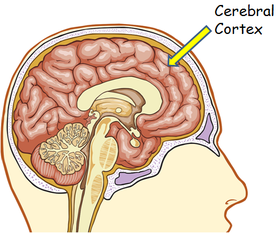Introduction to the Human Brain
A 3-pound mass of grey and white matter controls our every move, word, and breath. This complex organ regulates every body function we undergo- from opening a lid to running a marathon, it’s all controlled by the same place. Although the human brain is the essence of our being, it is hard to understand the brain itself. It’s many mysteries get even more amplified when considering how drugs alters these necessary life-living functions.
Brain Functions with Drugs
First , let’s go over the basic functions of the brain:
 The Cerebral Cortex– This is the most developed part of the human brain. It processes most things an individual experiences by controlling their thoughts, language, and perceiving events around them. It is divided into 4 lobes: frontal lobes, parietal lobes, temporal lobes, and occipital lobes. Each of these lobes have a cortex that has a specific job but we will only need to know the basics.
The Cerebral Cortex– This is the most developed part of the human brain. It processes most things an individual experiences by controlling their thoughts, language, and perceiving events around them. It is divided into 4 lobes: frontal lobes, parietal lobes, temporal lobes, and occipital lobes. Each of these lobes have a cortex that has a specific job but we will only need to know the basics.
The Brain Stem– This is most basic and easiest part of the brain to remember. It controls the one thing in life we need to live, breathing. It has other small jobs as well.
The Limbic System– This is a series of structures consisting of the amygdala, hippocampus, thalamus, hypothalamus. This system controls our emotions, perception of emotions, memories, and learning. It is activated by healthy activities such as being social and eating. It is also activated by drugs, which explains why drugs are mood-altering. I’ll get more into this later.
How Brain Transmits Information
Neuron– Think of neurons as relay race. There’s tons of different people with different jobs and once that job is over, they hand something to the next person indicating it’s their turn to do their job. Neurons receive the the messages that the nerve cells send from the brain.
Receptors– Think of these are the door before the message that the neurotransmitters have been carrying stop at. They attach to a receptor and this receptor is what makes the message act correctly.
How Drugs Effect the Brain
Ever wonder why drugs work so fast? It’s because they immediately attack the neurons working in our brain. The chemicals that are released from the drug gets trapped in the communication part of the brain. This interferes with how the neurons communication with each other. Since most drugs mimic the brains real chemicals, they fool the receptors and allow the drug to attach itself to a neuron. Heroine and marijuana activate these neurons because the chemicals that make them, resemble a neurotransmitter. Drugs basically trick the brain into thinking these chemicals are good for it.
After drugs make their way through the gated doors of our brain, they create this amazing sensation that spread over the body. This is because the chemicals in the drugs attack the brains rewards system. The brains reward system consists of releasing amounts of dopamine by how good a person feels. Dopamine is a chemical that is released when we feel good. With abnormally high numbers running through the veins, it makes for a strong reinforcement to do it again. Since our brain is wired to repeat things that make us feel good, these mood-high drugs become addictive. Eventually, the neurotransmitters cannot keep up with the amounts of dopamine running through the body so without these drugs the person usually becomes sad.
Studies
A study done by H. F. Fraser and G. D. Van Horn conducted a short, double blind study to see if direct addiction was satisfactory for developing a dependence on morphine and codeine- like drugs. They needed additional studies to determine the reliability of this theory to measure how dependent a person become and what compounds in certain drugs make them so addictive.
Conclusion
Drugs are mind-altering chemicals that could damage a person for longer than a short period of time. They effect most parts in the brain and should only be used if prescribed. The danger of prescribed drugs is a treat as well. Everything in moderation or it could be harmful to an individual.
Citations:

awesome job on the article Julia, I thought this was great because of the relevancy that it has to us. Drugs are everywhere in college and even over the counter drugs too. This really helped me understand the chemical side of drugs and I found it very interesting with the diagrams and information that you posted.